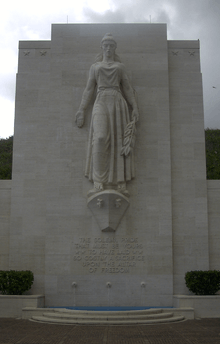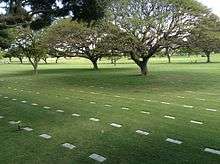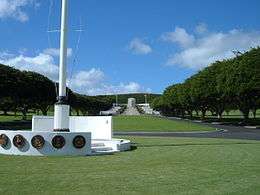National Memorial Cemetery of the Pacific
|
National Memorial Cemetery of the Pacific. | |
| Details | |
|---|---|
| Established | 1949 |
| Location | Honolulu, Hawaii |
| Country | United States |
| Coordinates | 21°18′45″N 157°50′47″W / 21.31250°N 157.84639°WCoordinates: 21°18′45″N 157°50′47″W / 21.31250°N 157.84639°W |
| Type | United States National Cemetery |
| Owned by | National Cemetery Administration |
| Number of graves | 34,000 |
| Find a Grave |
National Memorial Cemetery of the Pacific |


The National Memorial Cemetery of the Pacific (informally known as Punchbowl Cemetery) is a national cemetery located at Punchbowl Crater in Honolulu, Hawaii. It serves as a memorial to honor those men and women who served in the United States Armed Forces, and those who have given their lives in doing so. It is administered by the National Cemetery Administration of the United States Department of Veterans Affairs and is listed on the National Register of Historic Places. Millions of visitors visit the cemetery each year, and it is one of the most popular tourist attractions in Hawaii.
Location, construction and history
In February 1948, Congress approved funding and construction began on the national cemetery. Since the cemetery was dedicated on September 2, 1949, approximately 53,000 World War I, World War II, Korean War, and Vietnam War veterans and their dependents have been interred. The cemetery now almost exclusively accepts cremated remains for above-ground placement in columbaria; casketed and cremated remains of eligible family members of those already interred there may, however, be considered for burial.
Prior to the opening of the cemetery for the recently deceased, the remains of soldiers from locations around the Pacific Theater—including Guam, Wake Island, and Japanese POW camps—were transported to Hawaii for final interment. The first interment was made January 4, 1949. The cemetery opened to the public on July 19, 1949, with services for five war dead: an unknown serviceman, two Marines, an Army lieutenant and one noted civilian war correspondent Ernie Pyle. Initially, the graves at National Memorial Cemetery of the Pacific were marked with white wooden crosses and Stars of David—like the American cemeteries abroad—in preparation for the dedication ceremony on the fourth anniversary of V-J Day. Eventually, over 13,000 soldiers and sailors who died during World War II would be laid to rest in the Punchbowl. Despite the Army's extensive efforts to inform the public that the star- and cross-shaped grave markers were only temporary, an outcry arose in 1951 when permanent flat granite markers replaced them.
The National Memorial Cemetery of the Pacific was the first such cemetery to install Bicentennial Medal of Honor headstones, the medal insignia being defined in gold leaf. On May 11, 1976, a total of 23 of these were placed on the graves of medal recipients, all but one of whom were killed in action.
In August 2001, about 70 generic "Unknown" markers for the graves of men known to have died during the attack on Pearl Harbor were replaced with markers that included USS Arizona after it was determined they perished on this vessel. In addition, new information that identified grave locations of 175 men whose graves were previously marked as "Unknown" resulted in the installation of new markers in October 2002.
The National Memorial Cemetery of the Pacific contains a "Memorial Walk" that is lined with a variety of memorial markers from various organizations and governments that honor America's veterans. As of 2012, there were 60 memorial boulders (bearing bronze plaques) along the pathway. Additional memorials can be found throughout the National Memorial Cemetery of the Pacific—most commemorating soldiers of 20th-century wars, including those killed at Pearl Harbor.
"Operation Glory" and the Punchbowl Cemetery
After their retreat in 1950, dead Soldiers and Marines were buried at a temporary military cemetery near Hungnam, North Korea. During Operation Glory, which occurred from July to November 1954, the dead of each side were exchanged; remains of 4,167 US soldiers/Marines were exchanged for 13,528 North Korean/Chinese dead. In addition 546 civilians who died in United Nations prisoner of war camps were turned over to the South Korean Government.[1] After "Operation Glory" 416 Korean War "unknowns" were buried in the Punchbowl Cemetery. According to one report,[2] 1,394 names were also transmitted during "Operation Glory" from the Chinese and North Koreans (of which 858 names proved to be correct); of the 4,167 returned remains were found to be 4,219 individuals of whom 2,944 were found to be Americans of whom all but 416 were identified by name. Of 239 Korean War unaccounted for: 186 not associated with Punchbowl unknowns (176 were identified and of the remaining 10 cases four were non-Americans of Asiatic descent; one was British; three were identified and two cases unconfirmed).[3] Fifty-seven years after the Korean War, remains of two of the "Punchbowl unknowns" were identified—both from the 1st Marine Division. One was Pfc. Donald Morris Walker of Support Company/1st Service Battalion/1st Marine Division who was KIA December 7, 1950[4] and the other was Pfc. Carl West of Weapons Company/1st Battalion/7th Regiment/1st Marine Division who was KIA December 10, 1950.[5]
In 2011 remains of an unknown USAF pilot from Operation Glory were identified from the "Punchbowl Cemetery";[6] POW remains from "Operation Glory" were also identified in 2011.[7][8]
From 1990 to 1994, North Korea excavated and turned over 208 sets of remains—possibly containing remains of 200–400 US Servicemen—but few identifiable because of co-mingling of remains.[9] In 2011 remains were identified.[10]
From 1996 to 2006, 220 remains were recovered near the Chinese border. In 2008, a total of 63 were identified (26 World War II; 19 Korea; 18 Vietnam)[11] (Among those identified: January 2008 remains of a Michigan soldier.[12] In March 2008, remains of an Indiana soldier[13] and an Ohio soldier were identified). According to a report June 24, 2008, of 10 Korean War Remains disinterred from the "Punchbowl Cemetery" six have been identified.[14] From January to April 2009, a total of twelve Unknowns have been identified—three from World War II; eight from Korean War; one from Vietnam.[15] In 2011 remains returned in 2000 were identified.[16]
Honolulu Memorial
In 1964, the American Battle Monuments Commission erected the Honolulu Memorial at the National Memorial Cemetery "to honor the sacrifices and achievements of American Armed Forces in the Pacific during World War II and in the Korean War". The memorial was later expanded in 1980 to include the Vietnam War. The names of 28,788 military personnel who are missing in action or were lost or buried at sea in the Pacific during these conflicts are listed on marble slabs in ten Courts of the Missing which flank the Memorial's grand stone staircase.
The dedication stone at the base of staircase is engraved with the following words:
- IN THESE GARDENS ARE RECORDED
- THE NAMES OF AMERICANS
- WHO GAVE THEIR LIVES
- IN THE SERVICE OF THEIR COUNTRY
- AND WHOSE EARTHLY RESTING PLACE
- IS KNOWN ONLY TO GOD
At the top of the staircase in the Court of Honor is a statue of Lady Columbia, also known as Lady Liberty, or Justice. Here she is reported to represent all grieving mothers. She stands on the bow of a ship holding a laurel branch. The inscription below the statue, taken from Abraham Lincoln's letter to Mrs. Bixby, reads:
- THE SOLEMN PRIDE
- THAT MUST BE YOURS
- TO HAVE LAID
- SO COSTLY A SACRIFICE
- UPON THE ALTAR
- OF FREEDOM
Popular references
The statue is featured in the opening sequence of both the 1970s television series Hawaii Five-O and its 2010 remake. The latter series has also filmed at the cemetery several times — John McGarrett, the father of lead character, Steve McGarrett, is a Vietnam War veteran and supposedly buried near the statue.
Notable interments and memorials
- Donn Beach (1907–1989), born Ernest Raymond Beaumont Gantt, founder of Don the Beachcomber restaurants and inventor of the tiki bar
- John A. Burns (1909–1975), second state governor of Hawaii (1962–1974)
- John "Jack" Chevigny (1906-1945), Notre Dame football player (said, "that's one for the Gipper" in 1928 game) who was killed on Iwo Jima.
- Ralph Waldo Christie (1893–1987), Navy admiral involved with torpedo and submarine operations before and during World War II
- Norman "Sailor Jerry" Collins (1911–1973), prominent Honolulu tattoo artist
- Stanley Armour Dunham (1918–1992), grandfather of United States President Barack Obama
- Frank F. Fasi (1920-2010), six term mayor of the City and County of Honolulu
- Barney F. Hajiro (1916-2011), World War II Medal of Honor recipient
- Henry Oliver "Hank" Hansen (1919–1945), original Iwo Jima flag raiser
- Jasper Holmes (1900-1986) US Naval Intelligence analyst
- John J. Hyland (1912–1998), admiral and commander of the Pacific Fleet during Vietnam
- Daniel Inouye (1924–2012), World War II Medal of Honor recipient, Hawaii's first post-statehood Representative (1959–1963) and longtime Senator (1963–2012)[17]
- Douglas Kennedy (1915–1973), actor
- Young-Oak Kim (1919–2005), member of the 442nd Regimental Combat Team and first Asian-American to command a battalion in wartime
- Spark Matsunaga (1916–1990), U.S. Senator from Hawaii, member of the 442nd Regimental Combat Team
- Martin O. May (1922–1945), World War II Medal of Honor recipient
- Patsy Mink (1927–2002), U.S. Congresswoman from Hawaii and co-author of Title IX
- Allan M. Ohata (1918–1977), World War II Medal of Honor recipient
- Ellison Onizuka (1946–1986), first astronaut from Hawaii, killed in the Space Shuttle Challenger disaster
- Herbert K. Pililaau (1928–1951), Korean War Medal of Honor recipient
- Ernie Pyle (1900–1945), World War I veteran and Pulitzer Prize-winning World War II war correspondent
- William F. Quinn (1919–2006), territorial governor (1957–1959) and first state governor of Hawaii (1959–1962)
- Charles L. Veach (1944–1995), USAF fighter pilot and NASA astronaut
See also
References
- ↑ "Korean War Exchange of Dead – Operation GLORY". Qmmuseum.lee.army.mil. Retrieved 2013-11-13.
- ↑ "Korean War POW/MIA Network Operation Glory". Koreanwarpowmia.net. Retrieved 2013-10-25.
- ↑ DPMO Archived April 27, 2011, at the Wayback Machine.
- ↑ thedrifter08-27-07, 08:17 AM. "(August 2007)". Leatherneck.com. Retrieved 2013-11-13.
- ↑ http://192.156.19.109/marinelink/mcn2000.nsf/main5/4387FDD1AF66F38F8525736F005BE2F2?opendocument (October 2007) Archived May 29, 2011, at the Wayback Machine.
- ↑ "DPMO news release" (PDF). Retrieved 2013-11-13.
- ↑ "DPMO news release" (PDF). Retrieved 2013-11-13.
- ↑ "DPMO news release" (PDF). Retrieved 2013-11-13.
- ↑ "JPAC – Wars And Conflicts". Jpac.pacom.mil. 2008-07-29. Retrieved 2013-11-13.
- ↑ "DPMO News release" (PDF). Retrieved 2013-11-13.
- ↑ News Releases Archived May 2, 2008, at the Wayback Machine.
- ↑ "DPMO News release" (PDF). Retrieved 2013-11-13.
- ↑ "Remains from Korea identified as Indiana soldier – Army News, opinions, editorials, news from Iraq, photos, reports – Army Times". Armytimes.com. Retrieved 2013-11-13.
- ↑ Archived December 17, 2008, at the Wayback Machine.
- ↑ & & Archived January 14, 2009, at the Wayback Machine.
- ↑ "DPMO news release" (PDF). Retrieved 2013-11-13.
- ↑ "ABC-KITV News "Funeral services set for Sen. Inouye; viewing at U.S. Capitol followed by national then local services". Kitv.com. 2012-12-18. Retrieved 2013-11-13.
Further reading
- Sledge, Michael (2005 (2007)). Soldier Dead: How We Recover, Identify, Bury, and Honor Our Military Fallen. Columbia University Press. ISBN 0-231-13514-9. OCLC 81452881. Check date values in:
|date=(help)
External links
| Wikimedia Commons has media related to National Memorial Cemetery of the Pacific. |
- U.S. Department of Veterans Affairs: National Memorial Cemetery of the Pacific
- eGuide to National Memorial Cemetery of the Pacific
- "Honolulu Memorial, National Memorial Cemetery of the Pacific" (PDF). American Battle Monuments Commission Honolulu Memorial. Retrieved 2006-12-02.
- U.S. Geological Survey Geographic Names Information System: National Memorial Cemetery of the Pacific
- National Memorial Cemetery of the Pacific at Find A Grave
- Honolulu Memorial for MIAs located within the Punchbowl (Find a Grave)
- The short film STAFF FILM REPORT 66-20A (1966) is available for free download at the Internet Archive
- Historic American Buildings Survey (HABS) No. HI-3, "National Memorial Cemetery of the Pacific, 2177 Puowaina Drive, Honolulu, Honolulu County, HI", 43 photos, 4 photo caption pages
